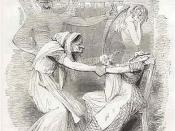I am going to assess the extent to which 'the Royal commission and 1834 Poor Law Amendment Act was a turning point in the provision of the welfare for the poor. To begin with I am going to look at what it was like before 1834.'
I am going to look at the old poor law, the working of the old poor law and how people were helped under it.
The 1601 Elizabethan Poor Law divided the poor into two groups: Firstly there was the impotent poor - the sick, elderly and those unable to work - who were to be helped via outdoor relief or in almshouses. These people were classed as "people whom would work but couldn't- the deserving poor ". Secondly there were a group whom were the able-bodied paupers and it was thought that these people "could work but wouldn't -the undeserving poor ". They were severely beaten until they realized they were in the wrong.
Relief was given in many different ways, and not all parishes had a poorhouse. It soon became obvious that some parishes were more sympathetic towards the poor in certain parishes, and so this caused many paupers to move from the parishes to ones in which were more generous. To prevent this from happening again parliament passed the '1662 Settlement Act':
This said that a person had to have a 'settlement' in order to obtain relief from a parish. But these settlement laws caused problems as it hindered the free movement of labour, it prevented men from leaving overpopulated parishes in search of work, from these settlement laws it meant that many men that might live in a parish for 25 years, working on short contracts, and they would still not be eligible for poor relief later on. These settlement laws...


